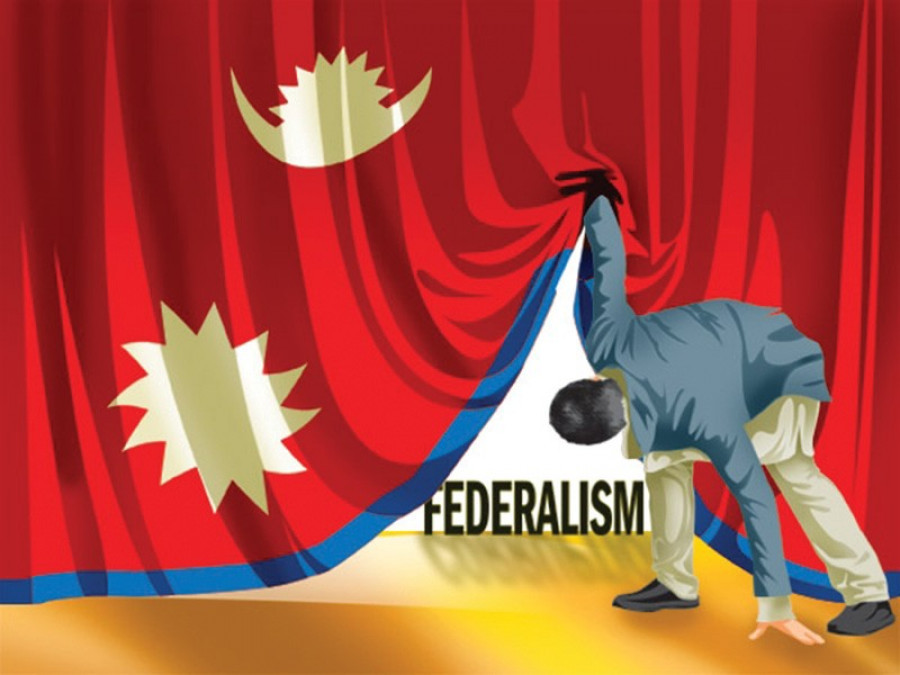Columns
Nepal's federalism: Time for a review
The first elected local governments under the federal constitution promulgated in 2015 are near completion of their five-year tenure.
Achyut Wagle
Despite several oddities and questions on its performance, Nepal's federal polity has achieved at least one crucial milestone: The first elected local governments under the federal constitution promulgated in 2015 are near completion of their five-year tenure. According to the Local Level Elections Act 2015, the tenure of the current elected office-bearers at the local level expires on May 20, 2022. Under Section 3 of the same act, elections to the local governments must be held two months before the expiry of the term. During a recent consultation with the government, the Election Commission has proposed the first or second week of May 2022 for these elections, and has reportedly begun its preparations. The first local elections under the federal system were held on May 14, 2017.
It is undoubtedly high time that the performance of the sub-national governments, both local and provincial, was given a dispassionate review vis-a-vis the constitutionally devolved powers and their demonstrated ability to exercise them or lack thereof. In the federal system, the performance of the local governments, in particular, is the key determinant for the success, or failure, of the very polity.
Comprehensive review
Perhaps the most important lesson of the last four and a half years of the local governments is that the elected local public officials could distinguish the degree of independence in exercising state power under the federal system against the earlier unitary one. A contingent interrogation mark related to their (desired versus demonstrated) ability has also concurrently risen. Both these facets provide the basis for a comprehensive review of the performance of the individual executives and federalism in its entirety as a politico-administrative system of the country.
Nepal apparently lacks independent policy research institutions of an academic nature with proven capacity to cover the entire nation at one go; and it is ideal that the government, for example, under the stewardship of the Ministry of Federal Affairs and General Administration carried out such reviews.
The parameters provided by the constitution for such a performance review of the subnational units, under Schedule 8 for the local and Schedule 6 for the provincial governments, should be adequate to initiate the evaluation. Similarly, three key indicators, namely the elected executives' understating of the federal devolution of authority, local governments' ability to manage and mobilise mainly financial resources and delivery of goods and services to their stipulated jurisdiction, or overall governance, may suffice to provide much-needed feedback before the next batch of elected representatives take charge after the next election.
Not surprisingly, during the initial years, the municipal governments seemed to have been overwhelmed by the responsibilities bestowed upon them by the constitution. This first led to confusion and eventually proved detrimental to the spirit of federalism. For instance, the existing education offices were dissolved and the responsibility of managing primary school education was handed over to the municipalities according to Schedule 8 (8) of the constitution. But, except for a few resource-rich ones, the local units, for all practical purposes, refused to shoulder this responsibility. As a result, the officially "defunct" district education office is still forced to operate, and the local units remain unresolved to fully manage the education system in their territory. Similar confusions persist in managing agricultural, health and cooperative services, harnessing natural resources and instituting municipal police services. Apart from the lack of manpower and knowledge of the elected representatives in these sectors, the lack of basic understanding about federalism's decision autonomy became the reason for the initial avoidance of these responsibilities. This only highlights the necessity of educating freshly elected executives about their duties and expectations before they are installed in office.
Despite the federal restructuring of the state, the country failed to unshackle itself from the chronic malaise of poor capital expenditure and resource absorption. Government statistics show that capital expenditure in local governments was only about 34.1 percent during the last fiscal year, less than half of the level of the federal government. This trend is more pronounced at the provincial level. According to a recent report, the provinces spent only 7.3 percent of their allocated capital budget in the first five months of the current fiscal year.
There are three distinct trends in resource management and mobilisation that do not augur well for the federal scheme. First, Nepal's federalism is monolithically becoming a "grant federalism". This has led to an almost homogenous tendency among the subnational governments to "supply" public goods only to the limits of the available grants. This certainly is a safe bet, but it will not encourage them to behave as a risk-taking independent government that seeks to upscale the delivery of public goods in response to demand-side perspectives.
Second, the municipalities have largely failed on both counts of effective budgeting and planning and enlarging their "source revenue" which provided ownership and latitude in resource mobilisation, including raising subnational loans, specifically for revenue-generating projects. And third, the practice of the much-touted cooperative federalism, in the particular light of sharing the benefits of positive externalities and also bearing the cost of the negative one, did not even commence across the federal units. All these are cumulatively adding currency to a peculiar narrative that "federalism also failed to deliver".
Crisis of governance
To put the suboptimal level of the supply of public goods by subnational governments aside, the extent of corruption and irregularities highlighted to be spiralling by constitutional bodies like the Commission for the Investigation of Abuse of Authority and the Office of the Auditor General is indeed a cause of great concern. These reports point to countrywide uniform trend of compromising transparency in public procurement, extensive conflict of interest prevalent among public officials, and apparent lack of a mechanism to contain these anomalies, promoting impunity and inviting political patronage along with political divisions.
If the country is in good faith, and willing to see the federal system succeed, the only strategy is its consolidation. This transition of leadership from the old to a new set of people's representatives is a unique window of opportunity to implement the lessons learnt during the last five-year exercise of federalism.




 6.21°C Kathmandu
6.21°C Kathmandu















